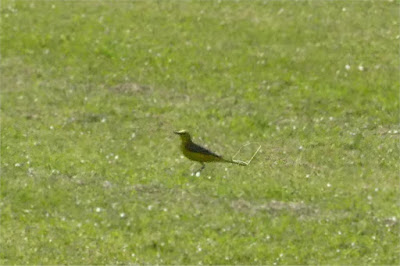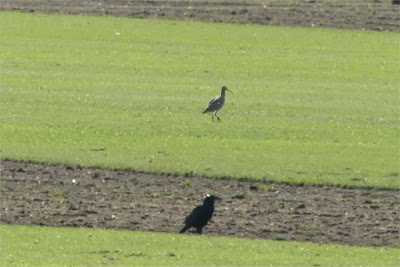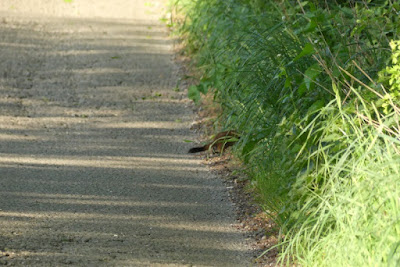 |
| Song thrush, Chat Moss |
Saturday seems to have become my set catching up with sleep day and for the first time this week I haven't heard the dawn chorus. As I've mentioned before, it's a bit more sparsely attended than usual this year. The chiffchaff and garden warbler were one-day wonders and the whitethroat seems to have given up on the territory it briefly established at the station. I've not seen or heard the mistle thrushes for a while and the song thrush wasn't a stayer. So we're left with the blackbirds, blackcap, robin, wren and woodpigeons. The collared doves don't fire up until mid-morning and the goldfinches and starlings are never sure whether or not they're songbirds. This year the structure of the dawn chorus is:
- About half an hour before dawn, sometimes earlier, one of the blackbirds starts singing. About five minutes later one of the others will kick in a response and they'll carry on well past dawn. Most days it's "my" blackbird starting the game rolling, sometimes the station blackbird. The blackbird over in the school grounds and the one down the road in the cherry trees are late risers and do most of their serious singing at twilight.
- Just before dawn, coinciding with the first passage of lesser black-backs overhead, the first of the woodpigeons starts singing. Some mornings only one will bother with the dawn chorus, a couple of times three have joined in.
- The robin's a late riser, which suggests to me that the territory's been taken by a new bird as his predecessor sometimes sang before the blackbirds. It sometimes sings in the dawn with the blackcap, most days it'll be half an hour or longer after dawn he starts singing.
- The wren is usually last to sing, at least half an hour after dawn. He and the blackcap will then spend most of the morning singing.
I thought I'd have a teatime stroll on the mosses. I'd walk up Astley Road onto Irlam Moss and if the ankle didn't feel up to it I could retreat down Roscoe Road and get the buses home. If there weren't any problems I'd carry on as usual.
The first two swifts of the year locally were swooping round the rooftops when I got home last night. This afternoon there were six of them wheeling and screeching over the station as I waited for the train.
 |
| Chaffinch, Irlam Moss |
I walked up Astley Road past the Zinnia Close spadgers and starlings. The turf had been stripped from the field on the right and the bare ground was peppered with pigeons and woodpigeons. I looked in vain for any partridges. Swallows visited a little damp hollow in the middle, I couldn't tell if they were drinking or collecting mud for nests. The hedgerows were noisy with blackcaps and chiffchaffs, joined by occasional blackbirds, robins and chaffinches. Way in the background a couple of skylarks sang. The goldfinches, greenfinches and great tits quietly got on with collecting food for the kids back home. As had been the chaffinch that decided to blow raspberries at me as I passed the Jack Russell's gate. A female kestrel flew by and was shouted at by goldfinches. A buzzard, that had been entirely ignored by the small birds, lumbered out of a roadside tree and floated over the fields.
 |
| Astley Road |
The ankle was feeling good. I'd felt some twinges walking from the station to Astley Road but once I left the pavements and slackened the pace to birdwatching tempo it was fine. At the junction with Roscoe Road I scanned over the bare fields behind Worsley View. The swallows were joined by a few house martins. I tried, and failed, to get photos of either. Rather to my astonishment a dozen oystercatchers flew in and started feeding on the field behind the farmhouse.
 |
| Oystercatchers, Irlam Moss |
 |
| House martin, Chat Moss |
I crossed the motorway and walked down the road past the turf fields. The lapwings I hadn't been seeing on Irlam Moss were dotted about the fields feeding with pied wagtails, magpies and crows. Only a couple seemed to be holding territories, and not doing anything with them. I hadn't been hearing any whitethroats, either, but they became a constant in the hedgerows and drains. Swallows and house martins swooped low over the fields; "low" for house martins being treetop height, there were more way up in the clouds. Trying to take photos of flying hirundines is a mug's game, I told myself, so I spent five minutes doing that.
 |
| Yellow wagtail |
I was picking out the runners and riders amongst the woodpigeons, crows, magpies and lapwings on one of the fields when a yellow wagtail flew in to feed amongst the pied wagtails. Fifty yards further along a whimbrel strutted about in the middle of the next field. I'm doing very well for them this Spring.
 |
| Whimbrel and carrion crow |
 |
| Lapwing |
I thought I'd have five minutes at Little Woolden Moss just to say I'd been. Although it was late afternoon there'd been plenty of butterflies about, mostly large whites and orange tips though I'd seen a couple of small whites and singles of small tortoiseshell and red admiral. As I walked down Lavender Lane a painted lady fluttered about the path, possibly brought in by the warm southerly winds.
The wooded entrance to Little Woolden Moss was alive with singing chiffchaffs, robins and willow warblers. It was late in the day to be expecting dragonflies so it was a nice surprise to find the trees busy with large red damselflies. A curlew flew over and headed for the fields. I walked down towards the pools, wrens and a linnet singing in the heather scrub and more willow warblers and a reed bunting in the birches.
 |
| Little Woolden Moss |
 |
| Little Woolden Moss |
The moss was in one of its generous moods. The dozen or so mallards included some half-grown ducklings and had a male shoveler tagging along with them. The Canada geese and lapwings were noisy, and had right to be as the female marsh harrier I often see about was on the prowl. I haven't seen any lapwing chicks so far this year, or hadn't until the harrier flew off with one with its parents in hot pursuit.
 |
| Painted lady, Chat Moss |
I headed back to Four Lanes End. The painted lady paused long enough on the path for me to take a photo and the damselflies were starting to settle down for the night in the trees. I expected the kestrel on the telegraph pole to be the usual male, it was one of last year's females. The pheasants, which I'd been hearing since Zinnia Close, were coming out into the fields to feed.
 |
| Large red damselfly |
Walking down Twelve Yards Road I had a nice surprise.
 |
| This stoat ran down the road as if to greet me as a long-lost friend… |
It won't be long before I'll start seeing the kittens playing in the lanes.
The bird song was unceasing. If any took a breath their places were taken immediately by others. Whitethroats and wrens sang in the drains; robins, blackbirds, chiffchaffs and chaffinches in the hedgerows; reed buntings and willow warblers in the willow scrub that's been planted, I think, for biofuel. One of the song thrushes hopped onto a fence to sing. The male kestrel was sitting near one of the farmhouses.
 |
| Lapwing |
Woodpigeons, stock doves and lapwings fed in the field under a ginormous hawk-shaped bird scarer that bobbed about ominously in the breeze. The Canada geese stayed at the far side of the field so at least the scarer stopped the crops getting flattened. The lapwings were being very territorial, indulging in bouts of aerial combat where they almost but never did crash into each other before returning to their partners.
 |
| Lapwings |
A couple of the fields had been reserved for late sowing. I'd been hearing mallards and assumed a distant flash of grey against the dark soil was a drake mallard until I got closer and saw it was the rump of a pheasant catching the late afternoon sunlight. The mallards were further along. A buzzard that had been digging for worms got too close to some lapwings and was chased off.
 |
| Pheasants |
The birdsong continued as I walked down Cutnook Lane. The blackbirds and song thrushes dominated the songscape. The ankle was nagging a bit but the tiredness of the legs was down to my having had a lazy week. Down at the bottom of the lane, by the motorway, half a dozen mallards fossicked about on the cut turf with gangs of mallards and carrion crows.
 |
| Chat Moss |
Coming out birdwatching at teatime has the benefit of avoiding the midday sun and catching a lot of birds as they're starting to settle down to sing before twilight. The downside is the infrequency of buses. I'd timed it right to catch the eight o'clock 100 bus that would give me seven minutes to cross the road at Irlam Station for my train home. A bit more, actually, as the train was running late. But not as late as the bus. So I waited half an hour for the 100 to the Trafford Centre and by some miracle made the connection with the 25 back home. Half a dozen swifts screeched over the rooftops as I rummaged for my front door key.
 |
| Twelve Yards Road |


No comments:
Post a Comment